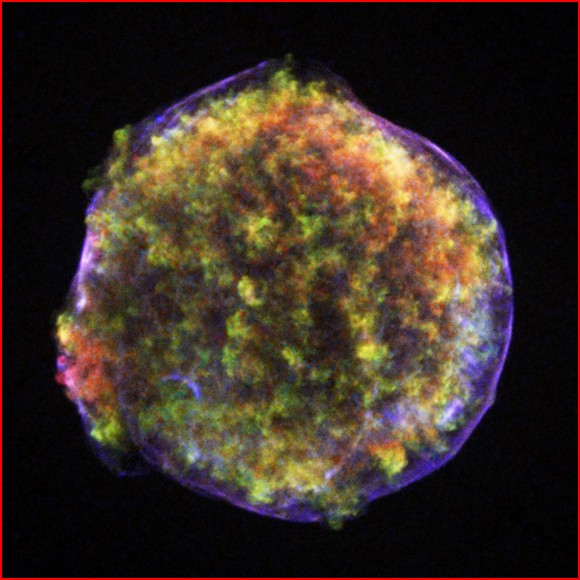Skip to comments.
Do nuclear decay rates depend on our distance from the sun?
the physics arXiv blog ^
| 8/29/08
Posted on 08/29/2008 9:29:09 AM PDT by LibWhacker
Here’s an interesting conundrum involving nuclear decay rates.
We think that the decay rates of elements are constant regardless of the ambient conditions (except in a few special cases where beta decay can be influenced by powerful electric fields).
So that makes it hard to explain the curious periodic variations in the decay rates of silicon-32 and radium-226 observed by groups at the Brookhaven National Labs in the US and at the Physikalisch-Technische Bundesandstalt in Germany in the 1980s.
Today, the story gets even more puzzling. Jere Jenkins and pals at Purdue University in Indiana have re-analysed the raw data from these experiments and say that the modulations are synchronised with each other and with Earth’s distance from the sun. (Both groups, in acts of selfless dedication, measured the decay rates of siliocn-32 and radium-226 over a period of many years.)
In other words, there appears to be an annual variation in the decay rates of these elements.
Jenkins and co put forward two theories to explain why this might be happening.
First, they say a theory developed by John Barrow at the University of Cambridge in the UK and Douglas Shaw at the University of London, suggests that the sun produces a field that changes the value of the fine structure constant on Earth as its distance from the sun varies during each orbit. Such an effect would certainly cause the kind of an annual variation in decay rates that Jenkins and co highlight.
Another idea is that the effect is caused by some kind of interaction with the neutrino flux from the sun’s interior, which could be tested by carrying out the measurements close to a nuclear reactor (which would generate its own powerful neutrino flux).
It turns out, that the notion of that nuclear decay rates are constant has been under attack for some time. In 2006, Jenkins says the decay rate of manganese-54 in their lab decreased dramtically during a solar flare on 13 December.
And numerous groups disagree over the decay rate for elements such as titanium-44, silicon-32 and cesium-137. Perhaps they took their data at different times of the year.
Keep em peeled beause we could hear more about this. Interesting stuff.
Ref: arxiv.org/abs/0808.3283: Evidence for Correlations Between Nuclear Decay Rates and Earth-Sun Distance
TOPICS: Science
KEYWORDS: catastrophism; decay; depend; distance; fstructureconstant; nuclear; physics; rates; stringtheory; sun
Navigation: use the links below to view more comments.
first previous 1-20 ... 41-60, 61-80, 81-100, 101-109 last
To: metmom
Seagulling onto threads is pretty common for some “frevos”.
In case you don’t know what that means, a seagull flies in from above, makes a bunch of noise, leaves his calling card and then flies away.
101
posted on
09/01/2008 6:26:52 PM PDT
by
Kevmo
(Obama Birth Certificate is a Forgery. http://www.freerepublic.com/tag/certifigate/index?tab=articles)
To: Quix
God may have a ‘thing’ for spinning things as He seems to for spirals.
***I get that impression as well, just by reading Ezekiel.
102
posted on
09/01/2008 6:27:50 PM PDT
by
Kevmo
(Obama Birth Certificate is a Forgery. http://www.freerepublic.com/tag/certifigate/index?tab=articles)
To: Kevmo
True. LOL.
I hadn’t connected that!
103
posted on
09/01/2008 7:00:01 PM PDT
by
Quix
(POL LDRS GLOBALIST QUOTES: #76 http://www.freerepublic.com/focus/news/2031425/posts?page=77#77)
Comment #104 Removed by Moderator
To: TXnMA
105
posted on
09/02/2008 2:51:30 AM PDT
by
Swordmaker
(Remember, the proper pronunciation of IE is "AAAAIIIIIEEEEEEE!)
To: r9etb
A change in the fine structure constant that varied with the distance from the Sun could also explain the Pioneer anomaly.
To: buckrodgers
107
posted on
09/03/2008 2:22:50 AM PDT
by
Straight Vermonter
(Posting from deep behind the Maple Curtain)
To: Kevmo
I remember reading a few months back someone came up with a direct way to measure the ( Fine structure constant ? ). I will see if I can find the article .
To: Kevmo
The values assigned to the decay-rate for particular isotopes are derived from laboratory experiments and statistical analyses of the raw data made available. Nuclear decay is not a deterministic (e.g., F=ma) type of phenomenon. It is a statistical estimate. Although there are many hypotheses about how matter acts at the atomic level, none have yet to be demonstrated to be comprehensive. I suspect that the variation in decay rate reported in this article is a simplistic way of describing statistical analysis results that have created a mean estimate that is several standard deviations (or other error measurement) away from the expected value(s).
109
posted on
09/14/2008 11:26:28 PM PDT
by
sefarkas
(Why vote Democrat Lite?)
Navigation: use the links below to view more comments.
first previous 1-20 ... 41-60, 61-80, 81-100, 101-109 last
Disclaimer:
Opinions posted on Free Republic are those of the individual
posters and do not necessarily represent the opinion of Free Republic or its
management. All materials posted herein are protected by copyright law and the
exemption for fair use of copyrighted works.
FreeRepublic.com is powered by software copyright 2000-2008 John Robinson
